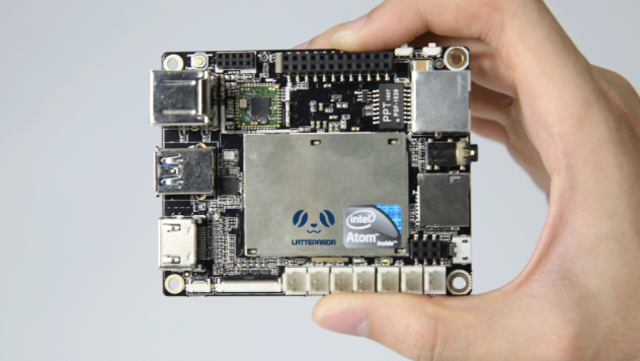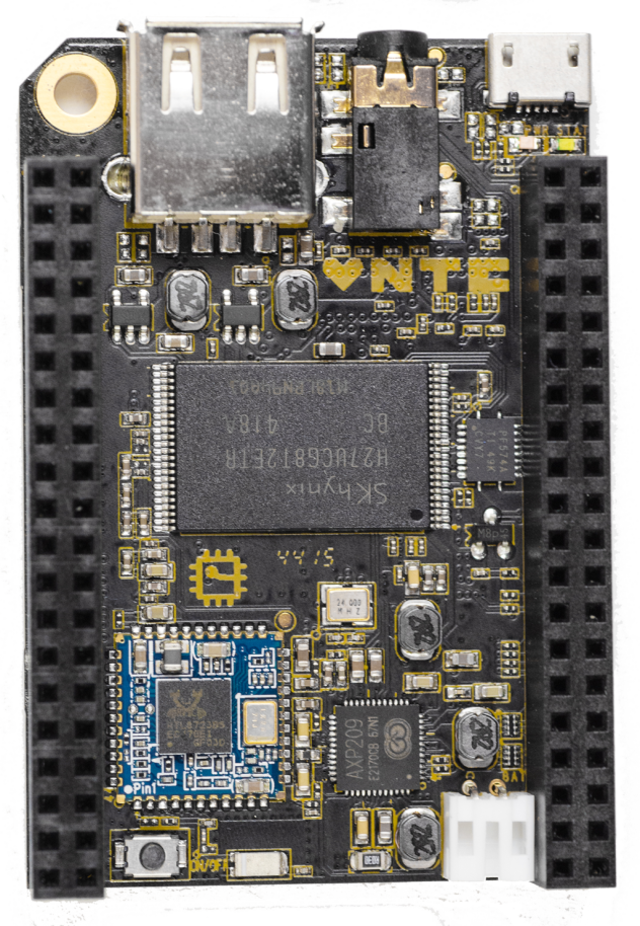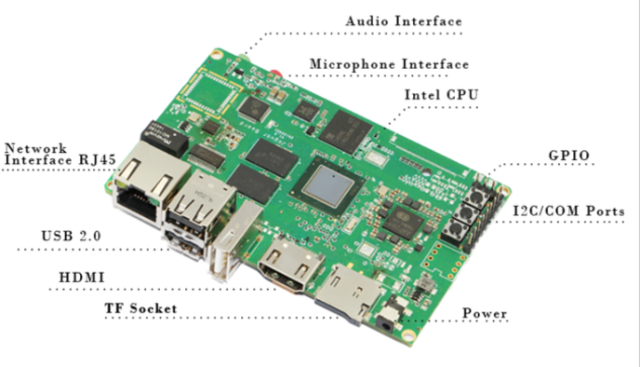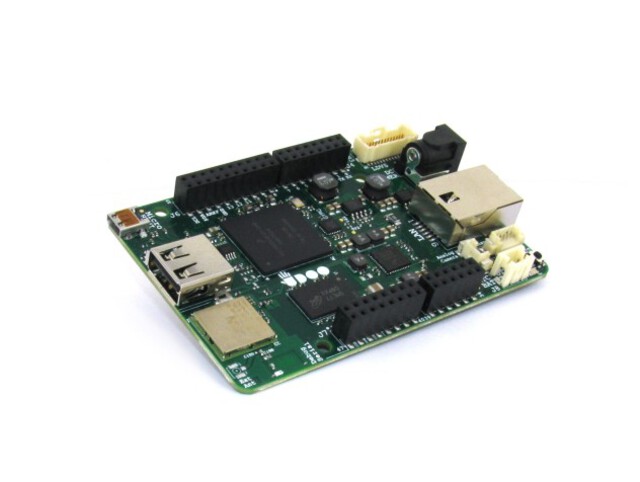6 SBCs to kick off 2016

It would seem that the Single Board Computer, (SBC), has reached it’s popularity peak, (or almost at it’s peak). A look at the top three crowd funding websites GoFundMe, KickStarter and IndieGoGo tells the tale. Here are some of the more interesting SBCs that you can find.
The term SBC is going to be muddied in coming years. There are already a number of SBCs that are more powerful than some desktops, and some embedded devices that are more powerful than classic SBCs. The following is a list of SBCs that stand out for either cheapness or versatility for the Maker. They are the ones that will do well in their targeted area, (with the exception of one).
Executive summary: The overall winner for the best, cheapest, most versatile SBC is the C.H.I.P.
The LattePanda was posted on kickstarter early December 2015, fully funded mid January 2016 with a delivery expected to start March 2016. This SBC is based on the Intel x5-z8300 Atom CPU that comes in two models. The base model has 2G RAM and 32G eMMC, and the higher end version, (LattePanda Enhanced), has 4G RAM and 64G eMMC. The base model has been arbitrarily priced at around US$79 and the Enhanced at US$129.
The LattePanda supports Windows 10, Android and Linux. However, there is no clear indication of what level of support there will be for Linux. Linux on SBCs has been plagued with GPU support issues with many distributions resorting to binary blobs to get around licensing issues. I would think that this board is no exception.
Support for the usual lineup of HDMI, USB, ethernet, and microSD is present, but also includes WiFi, Bluetooth 4.0, and WOL on ethernet. More interestingly, there are two aspects to this board that make it stand out further:
Firstly; they have decided to include an Atmega32u4 Arduino compatible chip onboard, with 20 GPIOs accessible from a header block to compliment the Atom’s 2 GPIOs. This effectively provides a real-time platform whilst the Intel Atom handles a lot of the grunt work.
Secondly; there is also support for a DSI touch screen, and 7x 3pin relimate connectors that are compatible with DFRobot’s “Gravity” series of sensors. Nice. This combined with the onboard Arduino expands the possibilities somewhat.
Specs:
- CPU: Intel Atom x5-Z8300 - Quad core 1.84GHz CPU / 500MHz GPU.
- GPU: Intel Gen8 - 500MHz, (supports up to 1080p 60Hz).
- RAM: 2 to 4G (LattePanda Enhanced) DDRL3L RAM.
- Storage: 32 to 64G (LattePanda Enhanced) eMMC & microSD.
- Video: HDMI.
- Voltage: 5v @ 2A.
- Power: Micro USB.
- Network: Wifi, Bluetooth 4 and 100Mbit ethernet with WOL, (Wake On LAN).
- USB: 2x 2.0 and 1x 3.0.
- GPIO: 2 GPIOs for the Atom, and 20 GPIOs for the Arduino.
- OS: Android, Linux and Windows 10.
- Size: 88mm x 70mm.
- 2 serial ports - 1 for each CPU.
- Integrated Atmega32u4 Arduino with compatible header.
- Headers for DSI touch screen, I2C, and 3.5mm audio.
- Headers for sensors - PIR, temperature, rotation/tilt, shock, LED, gas leak, LUX, flame, and relays.
Pros: WiFi, BLE, and sensor support. Cons: Support for Linux is uncertain. Summary: Would be a great board for robotics.
The CHIP is set to take the world by storm, and is a very strong competitor to the Pi Zero. Unless your head was in cloud computing for the last year you will know about the CHIP. However, here are some more details.
The CHIP was posted on kickstarter May 2015, and was successfully funded June 2015. “Successfully” is not the right word. Stampede of hackers is more likely. Delivery is expected June this year for pre-orders.
The CHIP is a $9 SBC sporting an ARMv7 based 1GHz Allwinner A13 CPU with 512M RAM and 4G NAND. 2x USB, composite AV, WiFi and BLE are builtin. All that for $9 makes this one of the best embedded devices yet.
With the addition of a VGA or HDMI shield and a keyboard you have an “instant computer”, (according to NextThing Co). Don’t expect it to be such with only 512M RAM. It’s more of a general purpose embedded computer than anything else, however there are people looking at using this as a platform to distribute to 3rd world countries.
There are 80 GPIO pins available for all your hacking needs, (the most of any SBC available), and can be powered from the USB port, LiPo battery or coin cell. Nice.
The hardware is open standard, which can be an issue with boards such as the Zero Pi.
Support for Linux, Android and Windows 10 is quite solid. It has been promised that Linux graphics support is mature, yet it remains to be seen how this works in the real world. Personally I don’t see this being a stumbling block in any way. They simply won’t be used for demanding graphics.
Specs:
- CPU: 1GHz Allwinner R8.
- RAM: RAM 512M.
- Storage: 4G NAND.
- Video: Composite onboard, HDMI and VGA with shield.
- Voltage: 5v.
- Power: Micro USB, 3.7V LiPo and coin cell.
- Network: 802.11b/g/n and Bluetooth 4.0.
- USB: 1x2.0 1x OTG.
- GPIO: 80.
- OS: Linux, Android and Windows 10.
- Size: 40mm x 60mm.
Pros: Cheap, small, open standards, connectivity, power options, GPIO available. Cons: The only thing I can think of - even though it can be, it’s not a desktop computer. Summary: Great for any small project requiring wireless connectivity, low power, low end, quick to market, out of the box battery support - IoT, monitoring, sensors, health.
The Up is a similar board to the LattePanda, however it aims to support the GPIO header block that has now become the Raspberry Pi industry standard. It was posted to kickstarter mid October 2015 and was successfully funded early December 2015. Pre-orders are currently running. This is one board that I backed, so I will be able to provide a full review of it once delivered.
It sports an Intel Atom x5-Z8300 quad core CPU running at 1.44GHz comparable to the LattePanda. Initially it was to be released with only 1G RAM, but backer pressure saw this up to 4GB. So now there are two models available; 2GB and 4GB.
The usual roundup of HDMI, ethernet and USB are there, except this supports Gigabit ethernet, and has in total 6 USB ports. Other connection options supported are; HMDI, DSI, and MIPI. Since this board supports all Raspberry Pi hats/shields it becomes a direct competitor to Raspberry Pi 2. The Raspberry Pi has issues with being locked into on older design, and does struggle with high I/O due to a shared bus. The architecture of the Up allows much higher I/O data transfer rates to be achieved consequently bringing USB 3.0 and gigabit ethernet to the table. Therefore the Up is essentially a Raspberry Pi on steroids. Expect all Raspberry Pi hats/shields supported as well as cases!
One other nice feature is that it has onboard RTC, (Real Time CLock). This is essential in some embedded applications.
The UP has also added Intel security features supporting the AES, (Advanced Encryption Standard), and the IIPT, (Intel Identity Protection Technology), standards which add an important security baseline for IoT applications.
The Up supports Windows 10, Linux and Android, (with the usual caveat on Linux graphics support).
- CPU: Intel Atom x5-Z8300 - Quad core 1.44GHz CPU / 500MHz GPU.
- GPU: Intel Gen8 - 500MHz, (supports up to 1080p 60Hz).
- RAM: 1G to 2G DDRL3L RAM.
- Storage: 16G to 32G eMMC and microSD.
- Video: HDMI.
- Voltage: 5v @ 2A.
- Power: Micro USB.
- Network: Wifi, Bluetooth 4 and Gigabit Ethernet.
- USB: 4x 2.0, 1x USB header and 1x 3.0 OTG / 2.0.
- GPIO: 40 GPIOs same as Raspberry Pi 2.
- OS: Windows 10, Linux and Android.
- Size: 85.60mm x 56.5mm.
- 1 serial port.
- RTC.
- Headers for DSI touch screen, I2C, MIPI camera, HMDI.
Pros: Raspberry Pi 2 on steroids. Cons: Lacks the same connectivity options as the LattePanda. Summary: Will be ideal as a drop-in replacement for the Raspberry Pi 2 where higher I/O performance is required - storage server, IoT gateway/hub, video server.
The Pine A64 is yet another ARM Cortex based SBC, except it claims to be “The first $15 64bit SBC”. Like the CHIP and Up Board it reached it’s target pretty quickly. It was posted to kickstarter early December 2015 and reached it’s target late January 2016. Pre-orders are being taken. This is another SBC I backed and once I have it in my hot little hands I’ll post up a review.There are three models to choose from. All three models run the ARM Cortex A53 at 1.2GHz and have inbuilt microSD, 2x USB 2.0, 3.5mm audio/microphone, HDMI with multi-channel audio, RTC, and the icing on the cake 3.7v LiPo battery charging support. The only difference separating the three models is RAM size and ethernet speeds.
- Base model: ($15), has 512MB RAM and 100MB ethernet.
- PineA64+: ($19), has 1G RAM, 1Gbit ethernet and 5Mpixel camera, 4 lane MIPI video, and DSI touch panel ports.
- PineA64+ 2G: ($29), has 2G RAM, 1Gbit ethernet and 5Mpixel camera, 4 lane MIPI video, and DSI touch panel ports.
The Pine also has a standard Raspberry Pi 2 GPIO header AND Euler GPIO header, so all hats/shields for both are theoretically supported, but since it is not the same form factor as the Pi2 nor Euler there may be issues with some modules. Additional options such as, DRM, (Digital Rights Management), secure boot, secure JTAG/eFuse, SPI, UART, and I2C are provided.
My hunch is that this SBC is more aimed at something like a media centre, or digital signage than a “traditional” embedded application. However it is cheap, has inbuilt Lithium charging support, and supports Raspberry Pi 2 / Euler GPIO hats/shields. It may be a strong contender to the Pi2, but I don’t think it has enough features for it to take it on.
The usual support for Windows 10, Linux and Android, (with the usual caveat on Linux graphics support).
- CPU: Quad-core ARM Cortex A53.
- GPU: Dual-core MALI-400 MP2, supporting 4Kp30 and 1080p60.
- RAM: 512M, 1G and 2G SDRAM RAM.
- Storage: microSD.
- Video: HDMI.
- Voltage: 5v @ 2A.
- Power: Micro USB.
- Network: Gigabit Ethernet and headers for separate WiFi and Bluetooh 4.0 module.
- USB: 2x 2.0.
- GPIO: Raspberry Pi 2 GPIO and Euler GPIO.
- OS: Windows 10, Linux and Android.
- Size: 127mm x 79mm.
- RTC.
- Headers for DSI touch screen, I2C, MIPI camera, HMDI.
- Supports Android, Linux and Windows 10.
Pros: Raspberry Pi 2 & Euler GPIO support. Price! Cons: Lack of features/price compared to CHIP. Summary: The only features that stand out on the Pine compared to the Pi2 are secure boot and faster CPU. Would be good, for example, in cases where secure digital signage is required.
The Jaguarboard is really more of the same, claiming to be “like Raspberry Pi but with better performance and x86 architecture”. Don’t expect it to be “like a Raspberry Pi” however as it does not support the Pi2 GPIO header. This made it’s debut on kickstarter end of December 2015 and just managed to limp to it’s target at the end of January 2016. Just.
This board runs an Intel Atom Z3735G quad core CPU clocked at 1.83Ghz and has 1G DDR3 RAM, and 16G eMMC storage with an additional TransFlash SDHC socket.
The usual connections are supported; HDMI, USB, 100Mbit ethernet, I2C, 2x UART. Only 3 USB 2.0 ports are provided. Additional features include “ATX style” power control, audio in.out, 4 GPIO pins, and 2 volume control buttons.
It runs Linux, Android and Windows 8.1. Linux support seems to be far better on this compared to the other SBCs.
This is the worst of all the boards on this list. The only redeeming features of this SBC is the TransFlash capability, and Linux support, but I’m sure there’s a market for it somewhere. I won’t hold my breath.
- CPU: Quad-core Intel Atom Z3735G.
- RAM: 1G DDR3L RAM.
- Storage: microSD and TransFlash.
- Video: HDMI.
- Voltage: 5v @ 2A.
- Power: Micro USB.
- Network: 100Mbit ethernet.
- USB: 3x 2.0.
- GPIO: 4.
- OS: Android, Linux and Windows 8.
- Size: “ATX” whatever that means.
Pros: Hmmmm. TransFlash and Linux support. Cons: Minimal features. Seems to be a poor attempt at matching what’s already there. Summary: Not sure what this board would be good for.
The UDOO Neo is an upgrade on the original UDOO that started life on kickstarter as well. It hit kickstarter at the end of April 2015 and was fully funded early June 2015. No limping over the line with this one.
This SBC claims to be “The Internet Of Things Board”, and is looking like it will live up to this claim. Like the LattaPanda it has both embedded and SBC processors onboard, except this runs a Freescale™ i.MX 6SoloX dual core CPU which embeds a 1GHz ARM® Cortex-A9, and up to a 200Mhz Cortex-M4 I/O real-time co-processor onto the same die. The best of both worlds!
It comes in three flavours, which is basically the same board but with additional components soldered on. Basic: 512M RAM, ethernet. Extended: 1G RAM, 802.11 b/g/n WiFi, Bluetooth 4.0, IMU. Full: 1G RAM, WiFI, Bluetooth, 9DOF IMU, Ethernet.
All three also come with 3 UARTs, 2x CAN bus, microSD, RTC, SPC, I2C, LVDS, HDMI with audio, S/PIDF, USB 2.0 and OTG, 22 Arduino and 32 ARM GPIO ports, and, surprisingly, an analog NTSC/PAL video in. Not sure what drove them to include an analog video input on this SBC, but it’s there.
Power can be either through the micro USB connector, or a separate 6-15V DC power jack. Nice for applications required in a car.
OS support is for Linux and Android only.
The fact that this SBC has features such as 6-15v power input, CAN bus and analog video input, (vehicle reversing camera), makes this an ideal fit for vehicle based projects such as OBDII vehicle fleet management devices. A nice little unit for $50.
- CPU: Freescale™ i.MX 6SoloX - 1GHz ARM Cortex A9 and 200MHz CortexM4.
- RAM: 512M and 1G.
- Storage: microSD.
- Video: HDMI & LVDS
- Voltage: 5v @ 1A.
- Power: Micro USB and 6-15V DC in.
- Network: Wi-Fi 802.11 b/g/n and BLE 4.0.
- USB: 1x 2.0 and 1x OTG.
- GPIO: 22 Arduino and 32 ARM.
- OS: Android and Linux.
- Size: 89mm x 59mm.
- Headers for DSI touch screen and I2C
- 9DOF IMU, CAN bus
Pros: Wide range DC power in, CAN bus. Cons: If used within a vehicle - none. Summary: As mentioned before; if the target application is for an in-vehicle OBDII fleet management unit, then this is one nice unit for $50.







